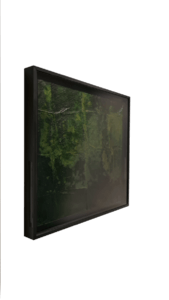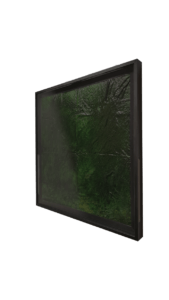Solaga
biological air purification from algae

Better air by algae
60 % of global oxygen is produced by algae.
Even medium CO2 concentrations are a productivity killer and lower our ability to think strategically.
Our algae picture - Alwe combines air purification and design, allowing one of the most effective oxygen suppliers on the planet to be elegantly integrated into the interior.
An algae image for air purification that inspires!
Alwe - the algae picture is the perfect combination of a biological air purifier and the aesthetic appearance of a wall decoration. This unique picture is fascinating and suitable for all rooms.
Alwe utilises the biological properties of microalgae to bind air pollutants and render them harmless. Just hang your Alwe on the wall like a conventional picture and it will immediately start cleaning your air.
Alwe-Dry
Alwe-Dry
a unique picture of preserved microalgae for the home
Our philosophy
Solaga is a biotech company, which has made it its business to free the air from harmful pollutants. To achieve this goal, we take advantage of the morphological properties of microalgae.
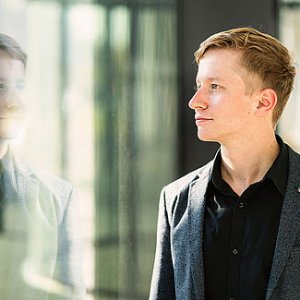
mission
Our mission is to rid the air we breathe of dangerous pollutants so we can all live longer, healthier lives.
vision
Our vision is to establish algae in society. Through the implementation of our projects, algae should be able to be used as biological air purifiers in all areas of life.
technology
Our technologies are based on the natural properties of microalgae. In nature, the small organisms use air pollutants as a nutrient medium for their growth.
Our solution - algae biofilm
In addition to large-scale projects such as facade greening and urban filters for city centers, we would particularly like to rid areas where we humans spend the most time of air pollutants. - In other words, our own homes and workplaces.
For this purpose, we developed the microalgae biofilm, consisting of living algae for air purification. Due to their physiological properties, these are able to absorb air pollutants such as fine dust, nitrogen oxides and other harmful chemicals, convert them and use them as a nutrient medium for their growth.
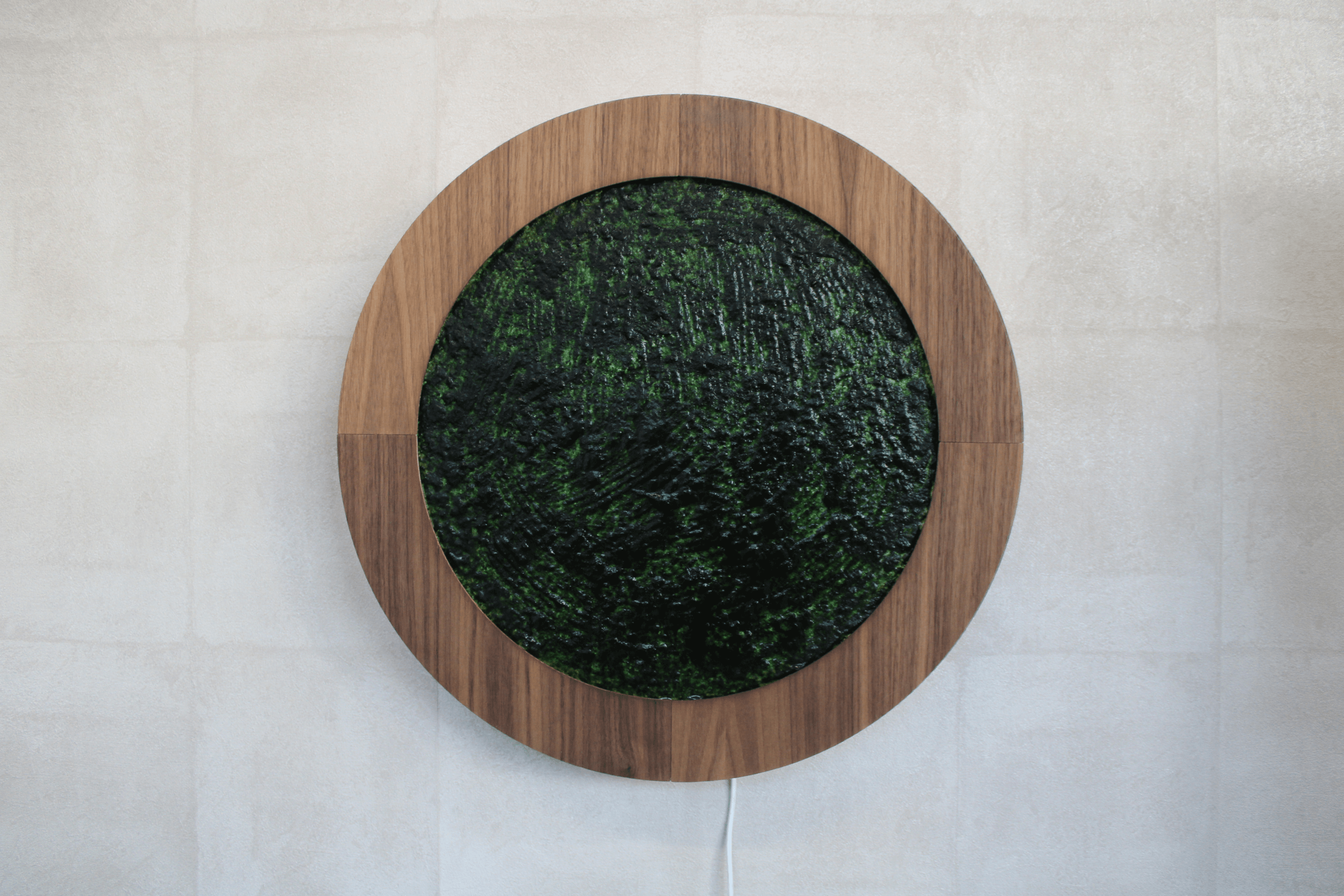
Awards
BIO Founders Competition
First place
Approximately 100 guests from science, business and politics selected from new innovations.
German Sustainability Award
Nominated
Our Alwe was nominated for the "German Sustainability Award Design 2021".
Deutschland Land der Ideen
Award winner
The project "Solar Gas Plant Solaga" is one of the 100 innovative winners of the competition.
It has been known for some time that greenery is good for the air indoors. Instead of monstera and rubber trees, the Berlin-based start-up Solaga relies on microalgae, such as those found under stones, whose photosynthesis is more efficient than that of plants.
German
With dire climate change reports landing one after another in 2018 the need for sustainable, scalable, and affordable biofuels to aid in this transition to a more sustainable future has never been greater.
Labiotech.eu
English
Our projects
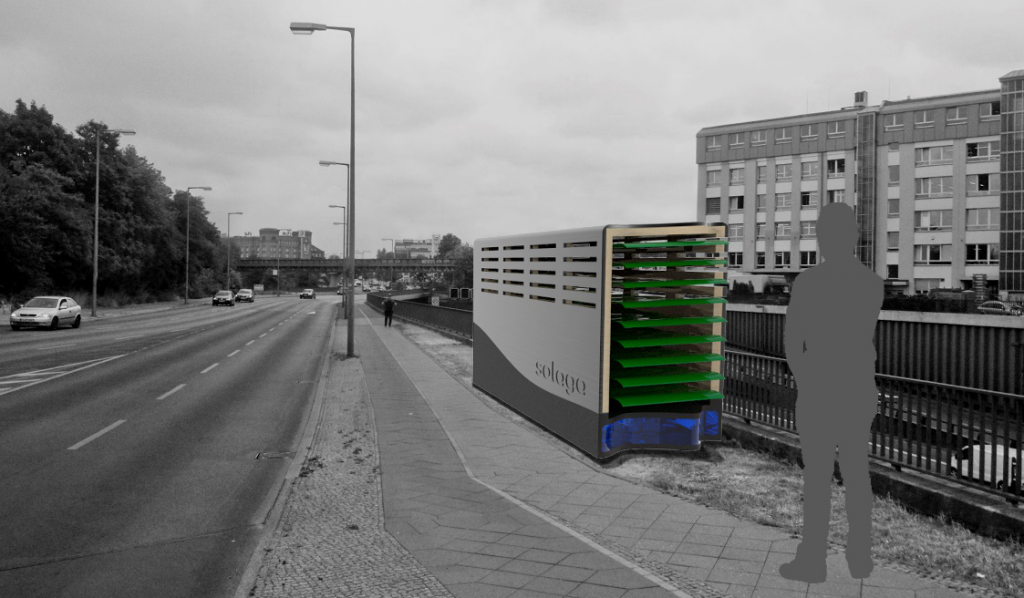
Multifilter
In development
Urban air purification
Algae, unlike plants, do not need a specific substrate - no "soil". Air purification in the urban algae filter is carried out by algae arranged in several stages, which remove pollutants from roads and industrial facilities.
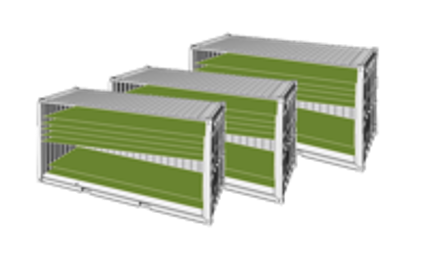
biogas
In development
Green energy
Algae not only absorb pollutants, but also produce valuable materials in the process. Solaga deals with the entry into a circular economy and researches the production and use for the bioeconomy and green energy sources: hydrogen and biogas.
FAQ
Microalgae are unicellular microorganisms that belong to the class of phototrophic organisms, i.e. they carry out photosynthesis. This means that microalgae, just like plants, use light to bind carbon dioxide and release oxygen.
Alwe - The algae image uses specially selected microalgae, which are found in nature especially under stones. As a result, these organisms are adapted to be active even under very difficult light conditions - such as those we find in our interiors - and to carry out effective photosynthesis, among other things. For this purpose they have developed extraordinary photosystems, which are clearly different from those of plants.
Microalgae have a more flexible metabolism than plants, for example, and can therefore break down a large number of pollutants.
The current dimensions of Alwe50 are 50x50x5cm. The weight is 1.2 kg when empty and about 1.5 kg when filled.
In biologically correct terms, the algae are blue-green algae, i.e. cyanobacteria. These are adapted to low light and have special pigments that enable photosynthesis even at the lowest light levels. This makes microalgae biofilms more efficient than plants and also air improvers in places where plants die mercilessly.
In investigations with the Federal Institute for Materials Research and Testing and the Technical University of Berlin, we have also discovered that microalgae biofilms can effectively bind air pollutants that are hazardous to health, such as nitrogen oxides and fine dust.
Initial tests at the Federal Institute for Materials Research and Testing also point to the reduction of volatile organic chemicals (VOCs) escaping from paints and building materials. Microalgae have a more flexible metabolism than plants, for example, and can therefore break down a large number of these pollutants.
Microalgae need light for their metabolism. Our algae picture is therefore best suited for rooms that are at least partially exposed to the sun.
However, please avoid attaching Alwe to surfaces that are often exposed to direct sunlight. If there is too much sunlight, more water will evaporate and the microalgae may start to break down their photo systems. The result is the fading of the biofilm. Should this happen, do not panic: Just leave Alwe in a shady place for some time and the biofilm will regenerate.
When designing Alwe, it was particularly important to us to keep the handling simple and manageable. That's why there is a small water tank in each Alwe, which needs to be refilled approximately every two weeks.
Yes, Alwe consists of living algae which adapt to the local light conditions. In shady areas the algae take on a deep green colour, as the micro-algae accumulate more pigments to absorb light more effectively. In semi-shade areas, the micro-algae need less pigments for successful photosynthesis and thus get a rather juicy and natural green colour.
In direct sunlight there is an overflow of energy in the algae. Under certain circumstances, this may cause the algae to actively break down their photo systems. The result is a colour change to light green or yellowish.
Algae films have not yet been researched in the long term, as these materials are completely new. However, we have not been able to identify any time limits in our previous R&D projects. Some of our algae films are already 4 years old and still healthy and productive, which is even more important. As algae films are living materials, no general statement can be made about their lifetime, as this obviously depends on care and local conditions. As far as we know, however, our biofilms are very robust, making them suitable even for users with brown rather than green thumbs.
With the purchase an Alwe we guarantee a minimum service life of 6 months. If problems occur within this period, you can return your Alwe without any problems and have it replaced by us.
Even after this period of 6 months you can of course always have your Alwe checked by us or you can try out one of our new biofilms. Please feel free to contact our service team.
In interiors, lighting in particular differs from natural light. Even with perceived bright interior lighting, the photosynthetically activating radiation is very low. This is because normal indoor lighting lacks the red and violet components of natural light that most plants need for photosynthesis. The microalgae biofilms we use, on the contrary, have special pigments that enable them to use light outside the red and violet spectrum for photosynthesis.
In addition, microalgae do not have roots or a stem and are therefore metabolically more effective compared to plants.
Our carefully cultivated microalgae belong to the so-called safety level 1, which describes organisms that are unlikely to have a negative effect on health. This means that they are not dangerous to animals, humans, plants or water and can be used without restrictions. Organisms from the food industry such as cultures of yoghurt or baker's yeast also belong to this safety class.
Our biofilms are produced under sterile conditions. Only when the biofilms have formed their characteristic protective skin layer are they released by us for usage in the algae image "Alwe".
BIO Founders Competition
First place
Approximately 100 guests from science, business and politics selected from new innovations.
German Sustainability Award
Nominated
Our Alwe was nominated for the "German Sustainability Award Design 2021".
Deutschland Land der Ideen
Award winner
The project "Solar Gas Plant Solaga" is one of the 100 innovative winners of the competition.
Air pollution
The World Health Organization (WHO) estimates that life expectancy in Europe will be reduced by up to 3 years due to the inhalation of air pollutants such as particulate matter and nitrogen oxides. Scientists at the Max Planck Institute for Chemistry and the University Medical Center Mainz calculated that, on a global average, life expectancy worldwide will be reduced by a staggering 2.9 years, resulting in around 9 million premature deaths. And the trend is upward. This makes the consequences of air pollution even more serious than cardiovascular risk factors such as cigarette smoking (2.2 years).
We as a company would like to stop this trend. With our biological, self-sufficient air filter system made of microalgae, we have declared war on air pollution!
Biological air purifier and green design
Biodegrading air pollutants with living wall elements
Biological Air Purifier
Natural algae filter pollutants from the air and release oxygen.
Suitable frame & easy care
The suitably designed frame of the algae image promotes air circulation and provides optimal watering through a water tank at the back.
Healthy air
Algae absorb all substances from the environment and remove not only CO² but also nitrogen oxides, fine dust and other gases. This makes the algae superior to plants and mosses.
Reinigungsleistung: 25 m²
Your Alwe delivery at a glance
Home delivery, 6 months warranty, easy replacement
Home delivery
After ordering in the webshop, the algae picture is conveniently delivered to their home. In addition, you will receive simple instructions, a suitable water bottle and fertilizer.
Lebenszyklus
Algen sind einem natürlichen Zyklus unterworfen und werden mit der Zeit etwas heller. Um eine optimale Filterleistung zu erhalten, empfehlen wir den Algenbiofilm jeden vierten Monat auszutauschen.
Easy exchange
Auf Anfrage senden wir Ihnen einen neuen natürlichen Biofilm, den Sie mittels eines Schiebesystems einfach gegen den alten Biofilm austauschen können, zu. Eine ausführliche Anleitung liegt dieser Lieferung ebenfalls bei. Außerhalb der Garantie kostet ein neuer Biofilm 59 Euro.
Air purification with algae: The algae picture from Solaga
Poor indoor climate is improved by algae
Alwe is the best answer to all these influences, because Alwe harnesses the survivability of living organisms to create clean air naturally:
Alwe is an eco-efficient wall decoration. The algae pattern brings life to the wall - space-saving and easy to clean. At the heart of Alwe is a living microalgae biofilm that actively binds and renders harmless air pollutants as an air purifier. Ventilation openings on the left and right sides integrate Alwe into the room's natural air circulation. Air pollutants are trapped on the moist surface of the microalgae biofilm. The trapped pollutants are then deactivated and consumed by the immobilized microalgae.

